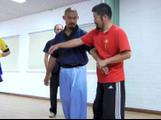Chen Style Taijiquan Practical Method employs 5 dimensions (layers). These 5 dimensions make up all the action combinations of Chen Style Taijiquan Practical Method. The “dimension” here is different from the scientific definition, more like the “plane” in English. The 5 dimensions are:
1. Dot
2. Line
3. Plane
4. Polyhedron/full
5. Movement
The dimension of Taiji is structural, but it can also be time/speed/rhythm.
Notes:
1. Dot: It refers to a simple point, not a ball-like dot that can be rotated. For example, if you point a dot on the paper with a pen, this dot cannot move at all.
2. Line: A line. For example, high-speed trains run on tracks. The track is a line. The train cannot go off the track.
3. Plane: A surface. The simplest example is the ground. If we say you can only be on the ground, then you can’t have both feet off the ground at the same time. Therefore, there is a rule in Chen Style Taijiquan Practical Method, which is jumping with both feet off the ground is not allowed.
In Taijiquan, the plane is usually horizontal or vertical: the horizontal is the ground or parallel to it; the vertical is like a wall, or parallel to it. The relationship between the vertical plane and Taiji is like rock climbing. You must attach onto the wall (vertical plane) with at least one dot, otherwise you will fail (fall off).
4. Polyhedron: It is an object that has both horizontal and vertical dimensions. This is a three-dimensional object in the ordinary sense.
5. Movement: Movement is something other than the above four. In the ordinary sense, we call it action, and it can also be the change of position, the passage of time, and so on.
Original post in Chinese by Master Chen Zhonghua. Translation-Yuxin Liu


